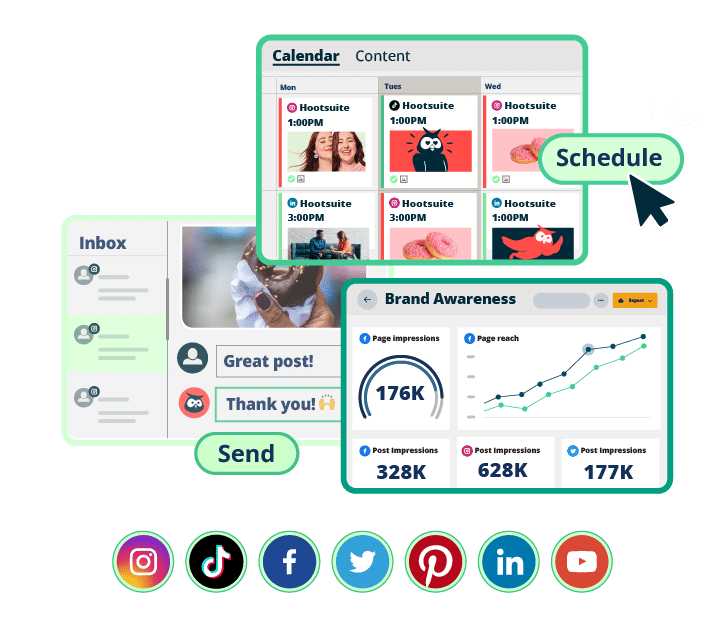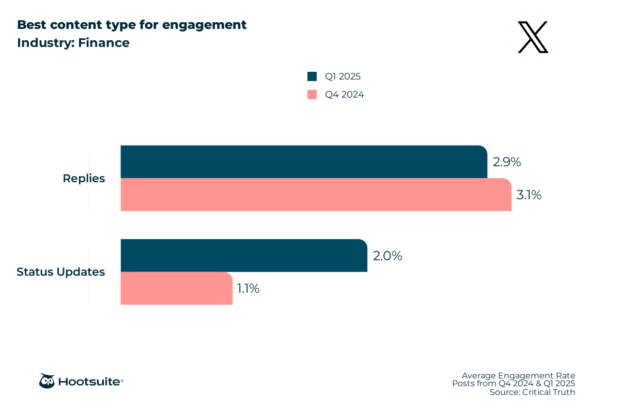If you’re using social media for marketing and communications at a bank, credit union, or other financial institution, you might find reporting on your progress tricky. How do you know if your strategy is working? Is an average of 100 comments per week good, or is it just average? And when is the best time to publish your content?
There is no universal answer — it all depends on factors like your sector, the platforms you’re using, your audience demographics, and more.
That’s where social media benchmarks come in. These numbers offer a clear view of what’s normal for your industry in terms of engagement and growth, helping you understand how your results compare.
Read on for the most recent social media benchmarks and stats specific to the FinServ industry that will put your performance into perspective. In this post, we break down the most recent available data (collected in Q1 of 2025).
Psst: Once you grab your benchmarks, head to our guide to using social media in financial services to find out how to action these insights.

Grow your client base with the tool that makes it easy to sell, engage, measure, and win — all while staying compliant.
Book a DemoBelow, you’ll find recommendations for the best times to post on Facebook, Instagram, Instagram Reels, TikTok, LinkedIn, and X (formerly Twitter) for maximum engagement.
Note: Time of day was localized across 118 countries where sample data came from, i.e. the graphs are accurate across time zones.
Best time to post on Facebook
According to our research, Monday mornings (8-9 am) and Tuesday nights (10 pm-12 am) are the best times for financial institutions to post on Facebook.

Best time to post on Instagram
On Instagram, posts published between 9-10 am on Wednesdays seem to generate the highest engagement for financial institutions.

Best time to post Instagram Reels
Per Hootsuite’s data, 5 am on Monday is the best time for financial institutions to post Instagram Reels.

Best time to post on TikTok
Thursday at 12 pm and Friday at 11 am are the best times for financial institutions to post on TikTok.

Best time to post on LinkedIn
LinkedIn engagement on profiles run by financial institutions stays consistent from Monday to Friday. That said, Monday (5-7 am), Tuesday (12-4 am), and Thursday mornings (3-4 am) are the best times to post.

Best time to post on X (Twitter)
Tweets tend to generate the highest engagement for financial institutions on X when posted on Wednesday between 1-2 pm and Thursday and Friday between 9-10 am.

Every financial institution’s ideal posting schedule is unique, and you should test different posting frequencies to find out what works best for your audience. That said, these industry-specific stats will help you find a data-informed starting point.
Our research found that financial institutions post on Facebook more often than on other social platforms — an average of 5.9 times a week. LinkedIn follows with an average of 5.3 posts per week.

Below, you’ll find network-specific data that illustrates how posting frequency corresponds to overall engagement rates.

On Instagram, a whopping 26 updates (posts, Stories, and/or Reels) per week generates the highest engagement rate at 4.64% in FinServ. However, posting 2 weekly updates garners slightly less engagement, at 4.16%.

On LinkedIn, Finance institutions that posted 2 times a week saw the highest average engagement.

On X (Twitter), FinServ institutions that posted two times a week have seen similar engagement rates to those posting an average of only five times per week.
Average engagement rates in financial services
Wondering if your engagement rates are high enough? Here are the industry averages across all major social networks as of March 2025:
- Instagram: 3.8%
- LinkedIn: 3.2%
- Instagram Reels: 3.1%
- TikTok: 1.6%
- X (Twitter): 2.1%
- Facebook: 1.8%

Different social networks offer different content formats — but how do you decide which should dominate your content mix?
Here’s what our research says.

On Facebook, album posts generate the most engagement — followed by status updates and posts with photos, videos, and links.

Instagram users particularly enjoy carousel posts, which — in finance — generate more engagement than photos or Reels.

On TikTok, videos reign supreme, generating the most engagement.

On LinkedIn, posts with photos and videos outperform posts with links.

Over on X (Twitter) replies carry more weight (2.9% engagement) than status updates (2% engagement).
Follower growth rate in financial services
If your social media strategy revolves around growing your audience, make sure you’re setting realistic goals. Here is how other FinServ profiles did in Q1 2025:
- Instagram: 2.26%
- TikTok: 0.98%
- Facebook: 0.61%
- LinkedIn: 0.51%
- X (Twitter): 0%

Hootsuite makes social marketing easy for financial services professionals. From a single dashboard, you can manage all your networks, drive revenue, provide customer service, mitigate risk, and stay compliant.





